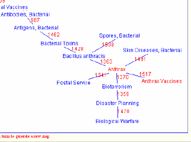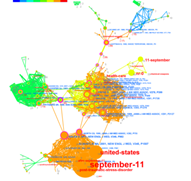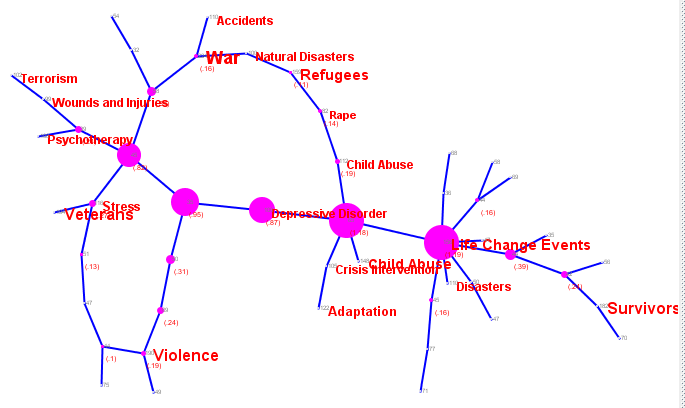|
|
|
Knowledge Discovery with Information Visualization
Funded and supported by the IBM Shared University Research (SUR) program,
a series of inter-related projects are currently underway at the College
of Information Science and Technology, Drexel University. These projects
apply various information visualization techniques to support data analysis,
concept exploration, and knowledge discovery in various health-related
information resources. A main goal of all the projects is to empower users'
cognitive ability when interacting with a vast amount of information.
Information visualization allows users to see, track and interact with
networks of concept relationships derived from the literature which otherwise
would be difficult to follow. The following projects demonstrate various
new ways of exploring, learning, and discovering in the digital information
environment.
DEMO
PROJECTS
(All the demo prototypes are developed in Java. You need to have a Java
plugin for your browser to test these systems. If you donot have it, click
here to download
Java plugin first.)
|
 Visual
Concept Explorer
Visual
Concept Explorer
|
Visual
Concept Explorer for exploration of semantic relationships of medical
concepts
Visual Concept Explorer (VCE) is a semantic mapping tool for exploring
the relationships of MeSH concepts. MeSH is the controlled vocabulary
thesaurus for the National Library of Medicine. VCE generates a
semantic map of MeSH terms most closely related to the term entered
by the user. The user can choose to have 25, 50, 75 or 100 MeSH
terms related to the search term displayed on the map. The map shows
how the terms are related to each other based on term co-occurrence
analysis of the entire MEDLINE database. The user can click on any
term that appears on the map to generate a new map for that term.
This iterative process guides the user in navigating through relationships
of complex medical concepts.
|
| |
|
|
 What's
New
What's
New
|
What's
New
"What's New" is a new exploratory visual interface for
PUBMED search engine. It provides an overview of a search result
before showing the details. The overview display indicates the distribution
of search results over the last 10 years and shows new concepts
that occur each year. The "More..." buttons allow the
user to take a more close look of each year's results. The user
can "pick and choose" from a list of concepts that occur
most often in the results and refine the search through new boolean
queries constructed visually.
|
| |
|
|
 CiteSpace CiteSpace
|
CiteSpace for
analyzing and visualizing networks derived from the literature
CiteSpace visualizations track the evolution of networks over time
and pinpoint pivotal points during the underlying transformation
process. In addition, the interactive visualizations allow the user
to use CiteSpace as a gateway to exploring online repositories of
scientific literature, such as PubMed, the ACM Digital Library,
and many special collections such as:
- Anasazi (1990-2003) - the collapsed civilization
- Mass Extinction (1981-2003) - the debates of mass extinction
- Heart Diseases (1990-2004) - clinical studies
- NSF IIS Awards (1998-2004) - thematic patterns in abstracts
of awarded projects
- JAMIA (1994-2004) - a hybrid network of frequently used terms
in and cited papers by the journal
- Terrorism (1990-2004) - shift of focus: terrorist bombing, bioterrorism,
and PTSD
Please contact Chaomei Chen at
chaomei.chen@cis.drexel.edu for additional information. |
|
|
|
|

MeSHSpace
|
MeSHSpace
This prototype allows the user to search for medical concepts in
UMLS directly. Two steps are involved. The initial search results
inform the user of many relevant concepts so that the user can select
a specific concept from the list of results for visualization. Based
on the selected concept and the size chosen by the user, the second
UMLS search will be launched to construct a network as specified.
The underlying functionality of MeshSpace is the same as Visual
Concept Exploer. They provide visualization of the same information
in different formats
Please contact Chaomei Chen at
chaomei.chen@cis.drexel.edu for additional information.
|
|

